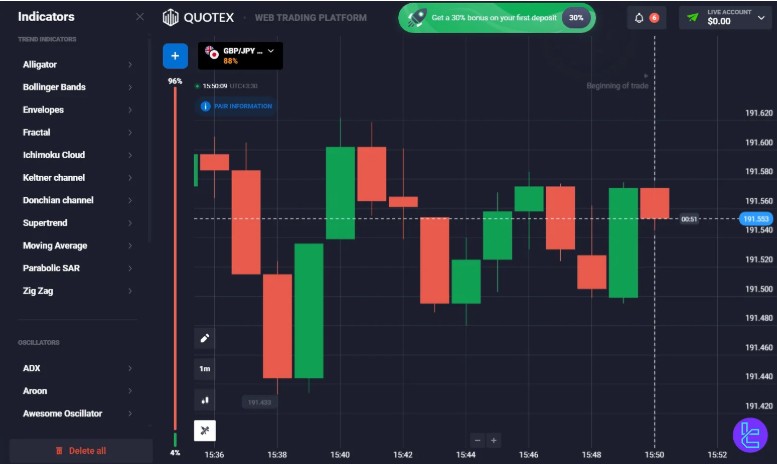5 Quotex Indicators You Shouldn’t Trade Without

Smart traders don’t guess. They read signals, assess data, and act based on what the charts tell them. The tools you use on the Quotex website can define whether your trades hit the target or miss by a mile. Indicators are essential, and knowing how to use them correctly is what separates consistent winners from frustrated beginners. If you’re trading without them, you’re skipping the most important part of market analysis. Below are five of the most powerful indicators on Quotex that you shouldn’t trade without—and how to use them like a pro.
1. Moving Average: Your Trend Navigator
When you first look at a chart, you may struggle to understand the market’s direction. The Moving Average (MA) simplifies that. It tracks the average closing prices over a specific period, smoothing out the noise and highlighting the overall trend. If the price is consistently above the MA line, the market is generally in an uptrend. This is incredibly useful on both short- and long-term trades. On the Quotex charts, you can easily switch between 10-day, 50-day, and 200-day moving averages. Many traders even use multiple moving averages together—like a 50-day and a 200-day—to spot golden crosses or death crosses, which often signal strong buying or selling opportunities.
2. RSI: Know When to Enter or Exit
The Relative Strength Index (RSI) is one of the most trusted tools for identifying overbought or oversold conditions. The asset can be overbought and in need of a correction if the RSI rises above 70. If it drops below 30, it could be oversold and poised for a reversal.
When it comes to timing your entry or departure positions, RSI is ideal. It works well across various assets, whether you’re trading currency pairs, commodities, or crypto. One of the advantages of using this tool on the Quotex official platform is how clearly it’s displayed alongside real-time chart movement. This helps you make faster and more confident decisions without flipping between tools.
3. MACD: Confirm the Trend’s Strength
MACD stands for Moving Average Convergence Divergence, and while it may sound complicated, it’s incredibly effective. This indicator displays how two moving averages, often the 12-day and 26-day, relate to one another. When it crosses below, it’s often bearish.
What sets MACD apart is that it doesn’t just show trend direction—it shows momentum. This can help you avoid entering trades too late or exiting too early. Watch the histogram bars for added confirmation; when they expand, momentum is growing. When they shrink, momentum may be slowing, and a reversal could be coming.
4. Bollinger Bands: Read Volatility Like a Pro
Markets don’t move in straight lines. They expand, contract, and break out when you least expect it. Bollinger Bands help you make sense of all that chaos. These bands wrap around a moving average and expand or contract depending on price volatility.
It can be overbought when the price reaches the upper band. By the time it reaches the lower band, it can be oversold. But Bollinger Bands are more than just buy or sell signals. If the bands suddenly widen, it often means a big move is coming. The market might be consolidating if they shrink.
Traders use this to their advantage by preparing for breakouts and identifying quiet moments before big moves. Quotex displays these bands in a clear visual format, helping you spot volatility changes in real time.
5. Stochastic Oscillator: Act on Fast Market Shifts
If you like to catch short-term reversals or scalp quick profits, the Stochastic Oscillator is your go-to tool. By comparing the current price of an asset to its range over a predetermined time period, it assists you in identifying changes in momentum.
The Stochastic Oscillator moves between 0 and 100. The asset can be overbought if the reading is higher than 80. When it’s below 20, it could be oversold. But what makes this tool even more powerful is its speed. It reacts quickly, giving you early signals before the rest of the market notices.
Combine this with trend direction from your moving average or momentum from MACD, and you’ve got a well-rounded setup for confident trading.
Final Thoughts
Trading with indicators isn’t about complicating things—it’s about improving your precision. When you use these five tools together, you gain a clearer picture of the market and reduce guesswork. Whether you’re looking for trend confirmation, volatility clues, or reversal signals, the Quotex website gives you everything you need to make smarter trades.
Take time to study how each of these indicators behaves in different markets. Practice using them in the demo account. Build confidence before jumping into live trades. The best traders aren’t just bold—they’re informed.





